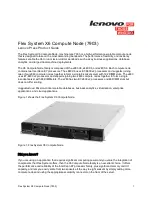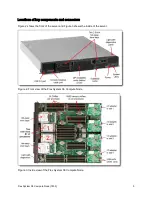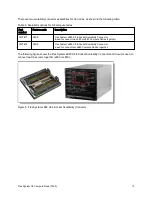
Flex System X6 Compute Node (7903)
3
PCI Express 3.0 I/O adapter slots that improve the theoretical maximum bandwidth by almost 100%
(8 GTps per link using 128b/130b encoding) compared to the previous generation of PCI Express 2.0
(5 GTps per link using 8b/10b encoding).
With Intel Integrated I/O Technology, the PCI Express 3.0 controller is integrated into the Intel Xeon
processor E7 v2 product families. This integration helps reduce I/O latency and increase overall
system performance.
Agile system design
The X6 Compute Nodes provides many scalability and flexibility features:
Innovative front-access scalable design where a customer can start with one x880 X6 Compute Node
with two sockets and simply add more processing power by inserting additional compute nodes into
the chassis (up to a total of four, depending on the processor selection) and mounting a scalability
connector to the front of all the compute nodes.
The usage of front-access scalability connectors means that you can easily scale the X6 system by
adding new compute nodes without removing existing compute nodes from the chassis.
With the usage of E7-8800 v2 processors, upgrading from a 2-socket (one compute node) to 4-socket
(two compute nodes) to 8-socket (four compute nodes) complex is as simple as inserting the extra
compute nodes and attaching the appropriate scalability connector to the front of all the compute
nodes. No tools are required. The usage of E7-4800 v2 processors allows an upgrade from a 2-socket
(one compute node) to 4-socket (two compute nodes) complex in the same way.
The usage of compute nodes as modular building blocks also allows clients to create the
configuration that fits their application and environment needs, which reduces acquisition costs while
giving them the flexibility to grow and modify their configuration later.
Using 64 GB LRDIMMs, each compute node supports up to 3 TB of memory and up to 6 TB in a
scaled complex.
Offers 4 PCIe 3.0 I/O slots per compute node, and up to 16 slots in an 8-socket scaled complex.
Resilient platform
The server provides many features to simplify serviceability and increase system uptime:
Advanced Processor Recovery allows the system to automatically switch access and control of
networking, management, and storage in the event of a processor 1 failure, providing higher
availability and productivity.
Advanced Page Retire proactively protects applications from corrupted pages in memory, which is
crucial for scaling memory to terabytes.
Redundant bit steering, memory mirroring, and memory rank sparing for redundancy in the event of a
non-correctable memory failure.
The Intel Execute Disable Bit function can help prevent certain classes of malicious buffer overflow
attacks when it is combined with a supported operating system.
Intel Trusted Execution Technology provides enhanced security through hardware-based resistance
to malicious software attacks, allowing an application to run in its own isolated space, which is
protected from all other software running on a system.
Redundant Intel Platform Controller Hub (PCH) connections to the processors allow the platform to
maintain access to networking, storage, and server management during a processor failure.
Hot-swap drives support RAID redundancy for data protection and greater system uptime.




































